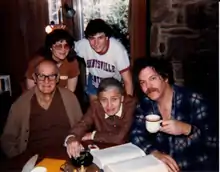Martin C. Weisskopf
Dr. Martin C. Weisskopf (born April 21, 1942)[1] is project scientist for NASA's Chandra X-ray Observatory and Chief Scientist for X-ray Astronomy in the Space Sciences Department at NASA's Marshall Space Flight Center in Huntsville, Alabama.[2]
Martin C. Weisskppf | |
|---|---|
 Weisskopf and family ca 1980 | |
| Born | April 21, 1942 |
| Nationality | |
| Alma mater | Oberlin College, Brandeis University |
| Occupation | Astrophysicist |
In 1964, he received his bachelor's degree with honors in physics from Oberlin College in Oberlin, Ohio, and in 1969 received his doctorate in physics from Brandeis University in Waltham, Massachusetts. Weisskopf began his post-graduate career at Columbia University in 1969, where he became an assistant professor and performed many pioneering experiments in X-ray astronomy. In 1977, Weisskopf left Columbia to become senior X-ray astronomer at Marshall Center and Chandra X-ray Observatory project scientist.[3]
Weisskopf has held numerous special appointments during his career. He is a senior co-investigator of the European Space Agency's international X-ray imaging experiment, called IBIS,[4] and the originator of a major experimental research program that began in 1978 that currently concentrates on the development of X-ray optics.[5]
He has served on numerous committees, including the National Academy of Science's Panel on High-Energy Astrophysics from Space, Astronomy, and Astrophysics Survey Committee. He is a member of the American Astronomical Society[6] and its High-Energy Astrophysics Division; the American Association for the Advancement of Science; the International Astronomical Union; Sigma Xi, a scientific research society; Phi Beta Kappa, the National Honor Society, and a Fellow of the American Physical Society, Astrophysics Division.[7]
Weisskopf is the recipient of numerous awards, including NASA Medals for Exceptional Service in 1992 and for Scientific Achievement in 1999.[8] He was elected in 1994 as a Fellow of the American Physical Society, which cited his "pioneering work in X-ray polarimetry and time variability studies of cosmic X-ray sources, and his insightful leadership as Project Scientist for the Advanced X-ray Astrophysics Facility." In 2001, he was selected as a fellow in the International Society for Optical Engineering (SPIE) for his significant scientific and technical contributions to the optics community and SPIE. In 2004, together with Dr. H. Tananbaum, he received the Rossi Prize of the High Energy Astrophysics Division of the American Astronomical Society which cited "their vision, dedication, and leadership in the development, testing, and operation of the Chandra X-ray Observatory"[9]
He is author or co-author of 225 publications including refereed journal articles, articles in books, monographs, and papers in conference proceedings.[10]
References
- Date in American Men and Women of Science, Thomson Gale 2004
- "Chandra Press Room :: CXC Biographies :: Dr. Martin C. Weisskopf". Chandra.si.edu. Retrieved 2016-12-02.
- "Chandra Press Room :: Chandra First Light Press Kit". Chandra.harvard.edu. Retrieved 2016-12-02.
- Ramsey, Brian (2009-11-03). "X-RAY VISION | SPIE Homepage". SPIE. Retrieved 2016-12-02.
- "Weisskopf Lecture". Slac.stanford.edu. Retrieved 2016-12-02.
- "Member Details | American Astronomical Society". Aas.org. Retrieved 2016-12-02.
- "APS -2013 Fall Meeting of the APS Division of Nuclear Physics - Bulletin of the American Physical Society". 58 (13). Meetings.aps.org. Retrieved 2016-12-02. Cite journal requires
|journal=(help) - NASA Exceptional Scientific Achievement Medal#Notable recipients
- "HEAD AAS Rossi Prize Winners | High Energy Astrophysics Division". Head.aas.org. Retrieved 2016-12-02.
- "Dr. Martin Weisskopf Honored with George W. Goddard Award". Spaceref.com. Retrieved 2016-12-02.